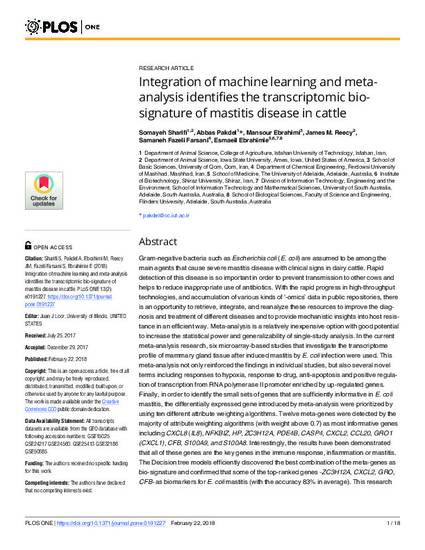
Gram-negative bacteria such as Escherichia coli (E. coli) are assumed to be among the main agents that cause severe mastitis disease with clinical signs in dairy cattle. Rapid detection of this disease is so important in order to prevent transmission to other cows and helps to reduce inappropriate use of antibiotics. With the rapid progress in high-throughput technologies, and accumulation of various kinds of ‘-omics’ data in public repositories, there is an opportunity to retrieve, integrate, and reanalyze these resources to improve the diagnosis and treatment of different diseases and to provide mechanistic insights into host resistance in an efficient way. Meta-analysis is a relatively inexpensive option with good potential to increase the statistical power and generalizability of single-study analysis. In the current meta-analysis research, six microarray-based studies that investigate the transcriptome profile of mammary gland tissue after induced mastitis by E. coli infection were used. This meta-analysis not only reinforced the findings in individual studies, but also several novel terms including responses to hypoxia, response to drug, anti-apoptosis and positive regulation of transcription from RNA polymerase II promoter enriched by up-regulated genes. Finally, in order to identify the small sets of genes that are sufficiently informative in E. coli mastitis, the differentially expressed gene introduced by meta-analysis were prioritized by using ten different attribute weighting algorithms. Twelve meta-genes were detected by the majority of attribute weighting algorithms (with weight above 0.7) as most informative genes including CXCL8 (IL8), NFKBIZ, HP, ZC3H12A, PDE4B, CASP4, CXCL2, CCL20, GRO1(CXCL1), CFB, S100A9, and S100A8. Interestingly, the results have been demonstrated that all of these genes are the key genes in the immune response, inflammation or mastitis. The Decision tree models efficiently discovered the best combination of the meta-genes as bio-signature and confirmed that some of the top-ranked genes -ZC3H12A, CXCL2, GRO, CFB- as biomarkers for E. coli mastitis (with the accuracy 83% in average). This research properly indicated that by combination of two novel data mining tools, meta-analysis and machine learning, increased power to detect most informative genes that can help to improve the diagnosis and treatment strategies for E. coli associated with mastitis in cattle.
Available at: http://works.bepress.com/james_reecy/124/

This article is published as Sharifi, Somayeh, Abbas Pakdel, Mansour Ebrahimi, James M. Reecy, Samaneh Fazeli Farsani, and Esmaeil Ebrahimie. "Integration of machine learning and meta-analysis identifies the transcriptomic bio-signature of mastitis disease in cattle." PloS one 13, no. 2 (2018): e0191227. doi: 10.1371/journal.pone.0191227.